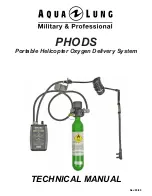
Liquiphant FTL64 with electronic insert FEL67
Appendix
Hauser
19
8.1.2
Description of application as a safety instrumented system
The sensor's tuning fork vibrates at its intrinsic frequency. The vibration frequency decreases
as the density increases. This change in the frequency causes the current signal to change.
The switch point is in the range of the tuning fork and depends on the installation position.
~13 (0.5)
~4 (0.16)
~12.5 (0.49)
D
A
B
C
D
D
A0037915
6
Switch point depending on the installation position. Unit of measurement mm (in)
A
Installation from above
B
Installation from below
C
Installation from the side
For information on the switch point under reference operating conditions, see the
Technical Information.
Correct installation is a prerequisite for safe operation of the device.
8.1.3
Measurement function
Choice of operating modes:
• MIN detection
The measuring system is used to protect against a level that is too low (e.g., pump dry
running protection, protection against emptying or protection against insufficient filling).
In normal operation, the tuning fork is covered by liquid and the measuring system reports
the OK status. If the tuning fork is free, the device assumes the safe state and signals the
demand mode.
• MAX detection
The measuring system is used to protect against a level that is too high (e.g., overfill
prevention).
In normal operation, the tuning fork is not covered by liquid and the measuring system
reports the OK status. If the tuning fork is covered, the device assumes the safe state and
signals the demand mode.
8.1.4
Versions
The components Liquiphant FTL64 with electronic insert FEL67 and Nivotester FTL325P may
be operated in the versions described in the Functional Safety Manual for the Nivotester
FTL325P (FY01006F).






































